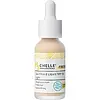What's inside
What's inside
 Key Ingredients
Key Ingredients

 Benefits
Benefits

 Concerns
Concerns

 Ingredients Side-by-side
Ingredients Side-by-side

Water
Skin ConditioningDimethicone
EmollientButylene Glycol
HumectantTrimethylsiloxyphenyl Dimethicone
Phenyl Trimethicone
Skin ConditioningPEG-10 Dimethicone
Skin ConditioningGlycerin
HumectantCaprylyl Methicone
Skin ConditioningPEG-9 Polydimethylsiloxyethyl Dimethicone
EmulsifyingCaprylic/Capric Triglyceride
MaskingPropylene Glycol
HumectantSodium Chloride
MaskingPhenoxyethanol
PreservativeTriethoxycaprylylsilane
Disteardimonium Hectorite
StabilisingNiacinamide
SmoothingSodium Dehydroacetate
PreservativeCaprylyl Glycol
EmollientDimethicone Crosspolymer
Emulsion StabilisingTriethyl Citrate
MaskingTetrasodium Glutamate Diacetate
Lycium Chinense Fruit Extract
AntioxidantTocopherol
AntioxidantCI 77491
Cosmetic ColorantCI 77492
Cosmetic ColorantCI 77499
Cosmetic ColorantCI 77891
Cosmetic ColorantWater, Dimethicone, Butylene Glycol, Trimethylsiloxyphenyl Dimethicone, Phenyl Trimethicone, PEG-10 Dimethicone, Glycerin, Caprylyl Methicone, PEG-9 Polydimethylsiloxyethyl Dimethicone, Caprylic/Capric Triglyceride, Propylene Glycol, Sodium Chloride, Phenoxyethanol, Triethoxycaprylylsilane, Disteardimonium Hectorite, Niacinamide, Sodium Dehydroacetate, Caprylyl Glycol, Dimethicone Crosspolymer, Triethyl Citrate, Tetrasodium Glutamate Diacetate, Lycium Chinense Fruit Extract, Tocopherol, CI 77491, CI 77492, CI 77499, CI 77891
Zinc Oxide 16.2%
Cosmetic ColorantAgave Tequilana Leaf Extract
AstringentBentonite
AbsorbentButyloctyl Salicylate
Skin ConditioningCaprylhydroxamic Acid
Capryloyl Glycerin/Sebacic Acid Copolymer
Skin ConditioningCaprylyl Glycol
EmollientCarthamus Tinctorius Oleosomes
EmollientCetearyl Alcohol
EmollientCetyl Alcohol
EmollientCoco-Glucoside
CleansingDiheptyl Succinate
EmollientGlycerin
HumectantHydrolyzed Wheat Protein/Pvp Crosspolymer
Iron Oxides
Jojoba Esters
EmollientMaltose
MaskingOctyldodecanol
EmollientSodium Gluconate
Skin ConditioningSodium Hyaluronate
HumectantSqualane
EmollientTocopherol
AntioxidantTrihydroxystearin
Skin ConditioningWater
Skin ConditioningZinc Oxide 16.2%, Agave Tequilana Leaf Extract, Bentonite, Butyloctyl Salicylate, Caprylhydroxamic Acid, Capryloyl Glycerin/Sebacic Acid Copolymer, Caprylyl Glycol, Carthamus Tinctorius Oleosomes, Cetearyl Alcohol, Cetyl Alcohol, Coco-Glucoside, Diheptyl Succinate, Glycerin, Hydrolyzed Wheat Protein/Pvp Crosspolymer, Iron Oxides, Jojoba Esters, Maltose, Octyldodecanol, Sodium Gluconate, Sodium Hyaluronate, Squalane, Tocopherol, Trihydroxystearin, Water
 Reviews
Reviews

Alternatives
Ingredients Explained
These ingredients are found in both products.
Ingredients higher up in an ingredient list are typically present in a larger amount.
Caprylyl Glycol is a humectant and emollient, meaning it attracts and preserves moisture.
It is a common ingredient in many products, especially those designed to hydrate skin. The primary benefits are retaining moisture, skin softening, and promoting a healthy skin barrier.
Though Caprylyl Glycol is an alcohol derived from fatty acids, it is not the kind that can dry out skin.
This ingredient is also used as a preservative to extend the life of products. It has slight antimicrobial properties.
Learn more about Caprylyl GlycolGlycerin is already naturally found in your skin. It helps moisturize and protect your skin.
A study from 2016 found glycerin to be more effective as a humectant than AHAs and hyaluronic acid.
As a humectant, it helps the skin stay hydrated by pulling moisture to your skin. The low molecular weight of glycerin allows it to pull moisture into the deeper layers of your skin.
Hydrated skin improves your skin barrier; Your skin barrier helps protect against irritants and bacteria.
Glycerin has also been found to have antimicrobial and antiviral properties. Due to these properties, glycerin is often used in wound and burn treatments.
In cosmetics, glycerin is usually derived from plants such as soybean or palm. However, it can also be sourced from animals, such as tallow or animal fat.
This ingredient is organic, colorless, odorless, and non-toxic.
Glycerin is the name for this ingredient in American English. British English uses Glycerol/Glycerine.
Learn more about GlycerinTocopherol (also known as Vitamin E) is a common antioxidant used to help protect the skin from free-radicals and strengthen the skin barrier. It's also fat soluble - this means our skin is great at absorbing it.
Vitamin E also helps keep your natural skin lipids healthy. Your lipid skin barrier naturally consists of lipids, ceramides, and fatty acids. Vitamin E offers extra protection for your skin’s lipid barrier, keeping your skin healthy and nourished.
Another benefit is a bit of UV protection. Vitamin E helps reduce the damage caused by UVB rays. (It should not replace your sunscreen). Combining it with Vitamin C can decrease sunburned cells and hyperpigmentation after UV exposure.
You might have noticed Vitamin E + C often paired together. This is because it is great at stabilizing Vitamin C. Using the two together helps increase the effectiveness of both ingredients.
There are often claims that Vitamin E can reduce/prevent scarring, but these claims haven't been confirmed by scientific research.
Learn more about TocopherolWater. It's the most common cosmetic ingredient of all. You'll usually see it at the top of ingredient lists, meaning that it makes up the largest part of the product.
So why is it so popular? Water most often acts as a solvent - this means that it helps dissolve other ingredients into the formulation.
You'll also recognize water as that liquid we all need to stay alive. If you see this, drink a glass of water. Stay hydrated!
Learn more about Water